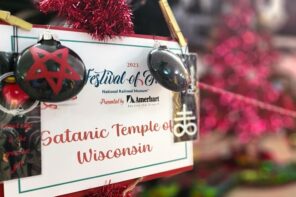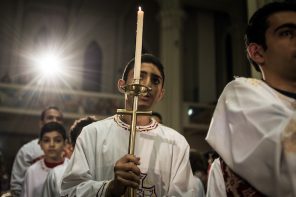In November, while governor Jay Nixon declared the controversy in Ferguson to be a state of emergency, another racially charged protest was under way in the Netherlands. On November 15 the town of Gouda (famous for its cheese) held an annual festival celebrating the arrival of Sinterklaas (Saint Nicholas) and his sidekick, a Spanish Moor named Zwarte Piet or “Black Pete.”
For decades, people in the Netherlands, Belgium, and Sweden have celebrated the start of the holiday season by dressing as Black Pete—complete with black face paint, red lipstick, and frizzy wigs—to distribute candy and serve the same function that Christmas elves do in America. It’s only since about 2011 that some have protested the practice as racist. This year 60 people were arrested for disruptive protesting—both for and against the tradition of dressing as Black Pete.
While Americans may snicker at this clearly backwards and racist tradition, it seems remarkably similar to our own controversy over the Washington Redskins. The tradition of Black Pete demonstrates that there is more to racism than asserting negative stereotypes or mistreating minorities.
Race is also a mythological category. The anthropologist Claude Levi-Strauss theorized that myth serves to take elements that oppose and contradict each other and to somehow “reconcile” them. When human beings create narratives and rituals to order their world, racial difference is one of the elements that must be accounted for and located within a larger pattern of meaning. One reason that racist institutions are so enduring is that they are often a source of meaning to the communities that support them. Black Pete is a source of joy to children just as some Redskins fans are emotionally invested in their offensive team name.
To be certain, the practice of dressing as Black Pete is racist and has direct consequences for racial minorities. In fact, the folklore surrounding Black Pete suggests that before taking his current benevolent form, Black Pete was a “Christmas devil” and foil to Saint Nicholas. While Nicholas rewarded good children, Black Pete carried a whip and a sack to punish or abduct naughty children. This makes Black Pete a close cousin of the Krampus—another European Christmas devil. Medieval iconography depicts Saint Nicholas with a devil bound to his service. The current image of Black Pete is attributed to an 1850 children’s book Sint Nikolaas en zijn Knecht (“Saint Nicholas and his Servant”).
The celebration of Black Pete suggests the festival is less about equating black people with devils and more about the mythic function of reconciling opposites as described by Levi-Strauss. For example, half of the “Black Petes” are women, who use the festival to transgress the binary of gender as well as race. Those seeking to compromise with protesters have suggested a coalition of Petes with White Petes, Yellow “Cheese” Petes, and Rainbow Petes. This move also suggests the mythic function of mapping and reconciling opposite elements.
The reactionary response to proposed changes is also significant. The Netherland’s anti-immigration Freedom Party has proposed legislation to secure the status of Black Pete. In a move that echoes America’s Christmas culture wars, The Freedom Party has descried “a war against Black Pete.”
Black Pete and Saint Nicholas are mirrored in American culture by a long tradition of white heroes aided by minority sidekicks such as the Lone Ranger and Tonto and the Green Hornet and Kato. The racial other can often appear superhuman, whether demonic or angelic. This is especially so in cultures that are racially and culturally homogenous.
There’s a universal impulse to incorporate racial difference into myths and rituals. Levi-Strauss’ essay “The Effectiveness of Symbols” describes a ritual used by South American shamans of the Cuna tribe to assist in birth. In order to heal his patient, the shaman calls upon all the spirits he can, including the spirit of “the silver streamer of the white man.” The problem currently unfolding in the Netherlands—and here in America—is that the racial other has been invested with mythic functions that cannot be reconciled with the actual reality of the racial other.
We may have a deep-seated need to populate the world with gods and monsters, but in a modern democratic society we must recognize the danger in using minorities as symbols of the mythic imagination. My Christmas wish is that one day Saint Nicholas will be assisted by a friendly Martian and we can all root for the Washington Werewolves.





